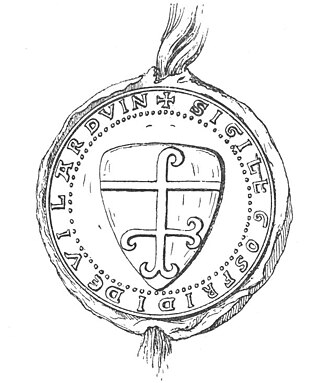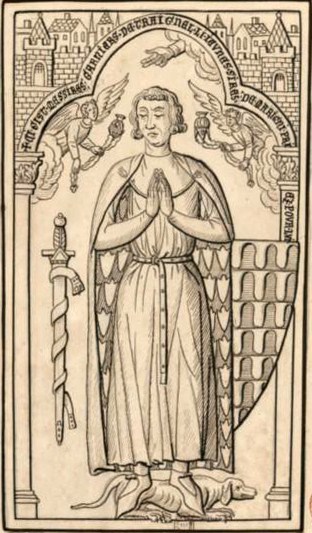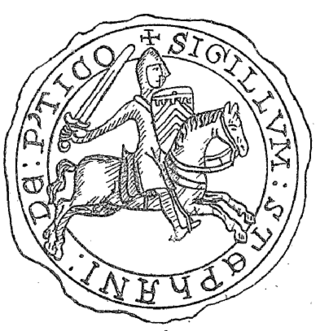
The Fourth Crusade (1202–1204) was a Latin Christian armed expedition called by Pope Innocent III. The stated intent of the expedition was to recapture the Muslim-controlled city of Jerusalem, by first defeating the powerful Egyptian Ayyubid Sultanate. However, a sequence of economic and political events culminated in the Crusader army's 1202 siege of Zara and the 1204 sack of Constantinople, rather than the conquest of Egypt as originally planned. This led to the Partitio terrarum imperii Romaniae or the partition of the Byzantine Empire by the Crusaders and their Venetian allies leading to a period known as Frankokratia, or "Rule of the Franks" in Greek.
Geoffrey of Villehardouin was a French knight and historian who participated in and chronicled the Fourth Crusade. He is considered one of the most important historians of the time period, best known for writing the eyewitness account De la Conquête de Constantinople, about the battle for Constantinople between the Christians of the West and the Christians of the East on 13 April 1204. The Conquest is the earliest French historical prose narrative that has survived to modern times. Ηis full title was: "Geoffroi of Villehardouin, Marshal of Champagne and of Romania".

William I of Champlitte (1160s-1209) was a French knight who joined the Fourth Crusade and became the first prince of Achaea (1205–1209).

Geoffrey I of Villehardouin was a French knight from the County of Champagne who joined the Fourth Crusade. He participated in the conquest of the Peloponnese and became the second prince of Achaea.

Geoffrey II of Villehardouin was the third prince of Achaea. From his accession to the princely throne, he was a powerful and respected person, and even French knights came to the principality to enter his service. Geoffrey II emerged as the most powerful vassal of the Latin Empire of Constantinople, the person around whom the crusaders' states in modern Greece gradually regrouped themselves. He came to the rescue of the imperial capital three times. As a reward of his services to the Latin Empire, he was granted suzerainty over the island of Euboea by his brother-in-law, Emperor Baldwin II of Constantinople (1228–1261). He was also a humane prince, benevolent and just, solicitous for the condition of the common people.

Othon de la Roche, also Otho de la Roche, was a Burgundian nobleman of the De la Roche family from La Roche-sur-l'Ognon. He joined the Fourth Crusade and became the first Frankish Lord of Athens in 1204. In addition to Athens, he acquired Thebes by around 1211.
Renier of Trit was a knight from Trith-Saint-Léger, Hainaut, who took part to the Fourth Crusade and became the first Frankish duke of Philippopolis from 1204 to 1205.
Vilain of Aulnay was a French knight from Aulnay-l'Aître in the Champagne who became marshal of the Latin Empire of Constantinople and first Baron of Arcadia in the Principality of Achaea. In the Greek version of the Chronicle of the Morea, he is attested as Βηλὲς ντὲ Ἀνόε, a form which passed to the other versions of the Chronicle as Anoé, Annoée or Anoée.
Berthold II von Katzenelnbogen was a German nobleman of the family of the Counts of Katzenelnbogen and a participant in the Fourth Crusade (1202–04), who became lord of Velestino (c.1205–17) and regent of the Kingdom of Thessalonica (c.1217) in Frankish Greece. He was a patron of poets and in politics a Ghibelline.
Philip was the second eldest son of Prince Philip I of Taranto and Thamar Angelina Komnene. His older brother, Charles, died in 1315. On 19 April 1319, his father granted him the title of Despot of Romania, which actually corresponded to rule over a small part of Albania, but also to the Prince of Taranto's claim on the Despotate of Epirus to the south. In May 1321, Philip was engaged to Beatrice, daughter of Count Louis I of Clermont. She brought as her dowry the 40,000 livres tournois, which Louis had agreed to pay Duke Odo IV of Burgundy in exchange for Odo's claim to the Principality of Achaea. Instead, Prince Philip had arranged to purchase Odo's rights for the same amount and marry his son to Louis's daughter. The engagement with Beatrice was canceled by 1329, when Philip married Violante (Yolanda), daughter of King James II of Aragon. In 1328, Philip's father decided to send a fleet to conquer the Despotate of Epirus. The fleet finally embarked in 1329. The younger Philip got as far as Nafpaktos, but on the eve of launching the land expedition, he died. Philip predeceased his father. Violante, his widow, died in 1353.

Guigues IV or Guy IV was the count of Forez, Auxerre and Tonnerre from 1203 and the count of Nevers from 1226. He was still a child when his father, Guigues III, died on the Fourth Crusade and he inherited Forez. His mother was Alix and his uncle, Renaud, archbishop of Lyon, acted as regent until he came of age in 1218.

Renard II, also spelled Reynald, Raynald, Rainard or Renaud, was the count or lord of Dampierre-le-Château in the Astenois. His lordship lay partly within the Holy Roman Empire, but he was also a direct vassal of the Count of Champagne in the Kingdom of France.

Garnier de Traînel was the bishop of Troyes from 1193 until his death. He took part in the Fourth Crusade (1202–1204) and in the founding of the Latin Empire.

Geoffrey V, nicknamed le Trouillard, was the Lord of Joinville from 1190 until his death in late 1203 or early 1204. He was also the hereditary seneschal of the County of Champagne. He went on both the Third Crusade (1189–90) and the Fourth Crusade (1202–04), where he died.
Robert of Nantes was the Latin patriarch of Jerusalem from 1240 to 1254.
Martin was the abbot of the Cistercian monastery of Pairis in Alsace, then part of the German kingdom in the Holy Roman Empire. Martin played a supporting role on the Fourth Crusade. He was a major source for the Historia Constantinopolitana, a history of the Fourth Crusade written by the monk Gunther of Pairis. Gunther's Historia serves as both a eulogy on the life of Martin and also an account of the translation of relics Martin brought to Pairis from the crusade. Gunther describes Martin as pleasant-looking, affable, eloquent, humble and wise.

Stephen du Perche was a French nobleman and crusader. He was a partisan of the Plantagenets in their conflict with the French crown and held fiefs from them. A younger son, he governed the County of Perche on behalf of his father and brother during their absence on crusade. He himself joined the Fourth Crusade in 1202 and travelled to the Holy Land. Afterwards, he went to the Latin Empire and was appointed duke of Philadelphia in Asia Minor in 1204. He died in battle against the Bulgars.
Thierry of Flanders was a Flemish nobleman and crusader active in 1197–1207.
Guy was the sixth Cistercian abbot of Vaux-de-Cernay from 1181 until 1210 and then the bishop of Carcassonne from 1212 until his death. The crusades dominated his life. He was a preacher, organizer and spiritual leader of the Fourth Crusade, which he abandoned after it turned against fellow Catholics, and also of the Albigensian Crusade against heretics.
Walter II was the bishop of Autun from 1189 until 1223.